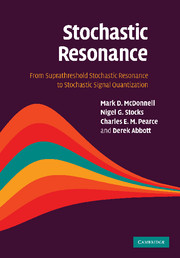Book contents
- Frontmatter
- Contents
- List of figures
- List of tables
- Preface
- Foreword
- Acknowledgments
- 1 Introduction and motivation
- 2 Stochastic resonance: its definition, history, and debates
- 3 Stochastic quantization
- 4 Suprathreshold stochastic resonance: encoding
- 5 Suprathreshold stochastic resonance: large N encoding
- 6 Suprathreshold stochastic resonance: decoding
- 7 Suprathreshold stochastic resonance: large N decoding
- 8 Optimal stochastic quantization
- 9 SSR, neural coding, and performance tradeoffs
- 10 Stochastic resonance in the auditory system
- 11 The future of stochastic resonance and suprathreshold stochastic resonance
- Appendix 1 Suprathreshold stochastic resonance
- Appendix 2 Large N suprathreshold stochastic resonance
- Appendix 3 Suprathreshold stochastic resonance decoding
- References
- List of abbreviations
- Index
- Biographies
3 - Stochastic quantization
Published online by Cambridge University Press: 23 October 2009
- Frontmatter
- Contents
- List of figures
- List of tables
- Preface
- Foreword
- Acknowledgments
- 1 Introduction and motivation
- 2 Stochastic resonance: its definition, history, and debates
- 3 Stochastic quantization
- 4 Suprathreshold stochastic resonance: encoding
- 5 Suprathreshold stochastic resonance: large N encoding
- 6 Suprathreshold stochastic resonance: decoding
- 7 Suprathreshold stochastic resonance: large N decoding
- 8 Optimal stochastic quantization
- 9 SSR, neural coding, and performance tradeoffs
- 10 Stochastic resonance in the auditory system
- 11 The future of stochastic resonance and suprathreshold stochastic resonance
- Appendix 1 Suprathreshold stochastic resonance
- Appendix 2 Large N suprathreshold stochastic resonance
- Appendix 3 Suprathreshold stochastic resonance decoding
- References
- List of abbreviations
- Index
- Biographies
Summary
By definition, signal or data quantization schemes are noisy in that some information about a measurement or variable is lost in the process of quantization. Other systems are subject to stochastic forms of noise that interfere with the accurate recovery of a signal, or cause inaccuracies in measurements. However stochastic noise and quantization can both be incredibly useful in natural processes or engineered systems. As we saw in Chapter 2, one way in which noisy behaviour can be useful is through a phenomenon known as stochastic resonance (SR). In order to relate SR and signal quantization, this chapter provides a brief history of standard quantization theory. Such results and research have come mainly from the electronic engineering community, where quantization needs to be understood for the very important process of analogue-to-digital conversion – a fundamental requirement for the plethora of digital systems in the modern world.
Information and quantization theory
Analogue-to-digital conversion (ADC) is a fundamental stage in the electronic storage and transmission of information. This process involves obtaining samples of a signal, and their quantization to one of a finite number of levels.
According to the Australian Macquarie Dictionary, the definition of the word ‘quantize’ is
1. Physics: a. to restrict (a variable) to a discrete value rather than a set of continuous values. b. to assign (a discrete value), as a quantum, to the energy content or level of a system. 2. Electronics: to convert a continuous signal waveform into a waveform which can have only a finite number (usually two) of values.
- Type
- Chapter
- Information
- Stochastic ResonanceFrom Suprathreshold Stochastic Resonance to Stochastic Signal Quantization, pp. 47 - 58Publisher: Cambridge University PressPrint publication year: 2008



